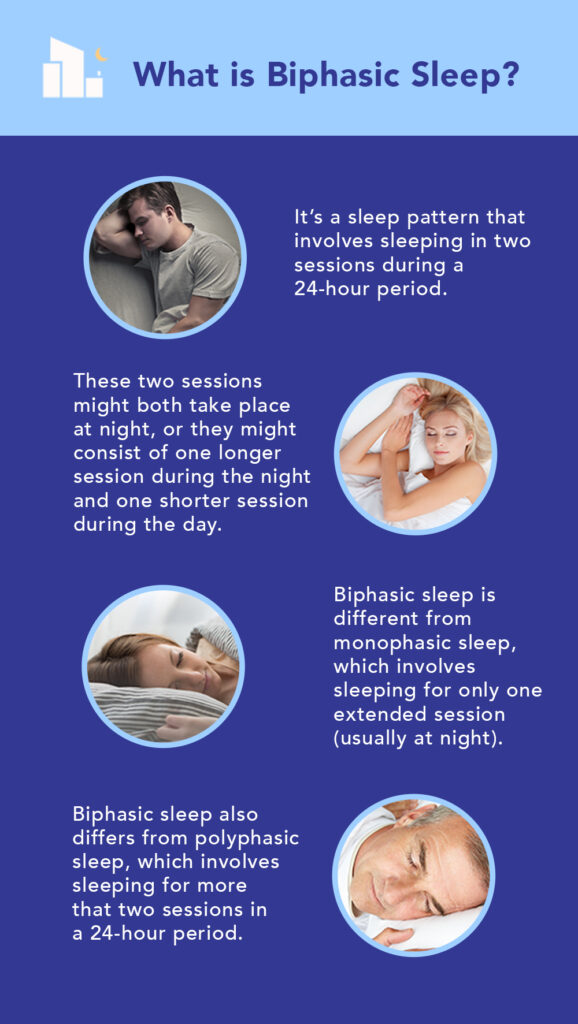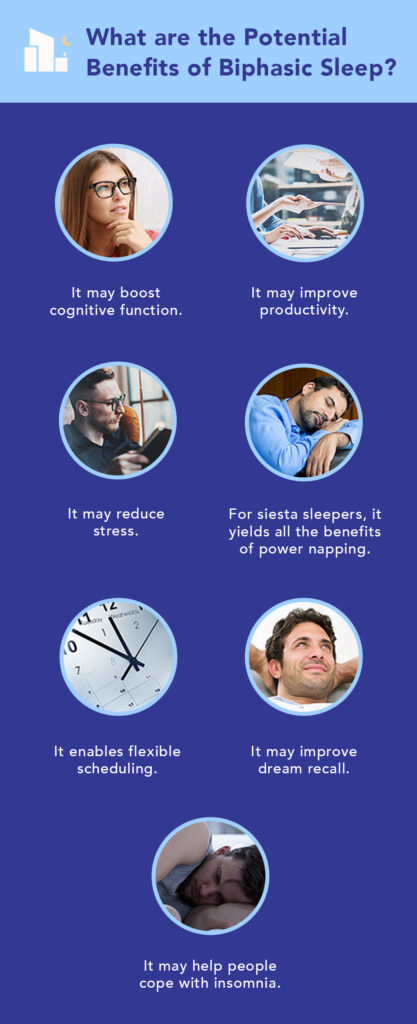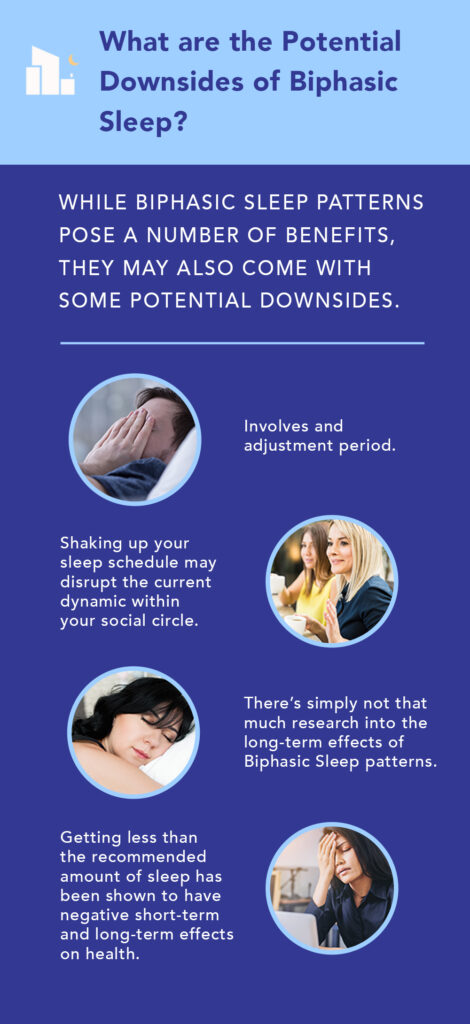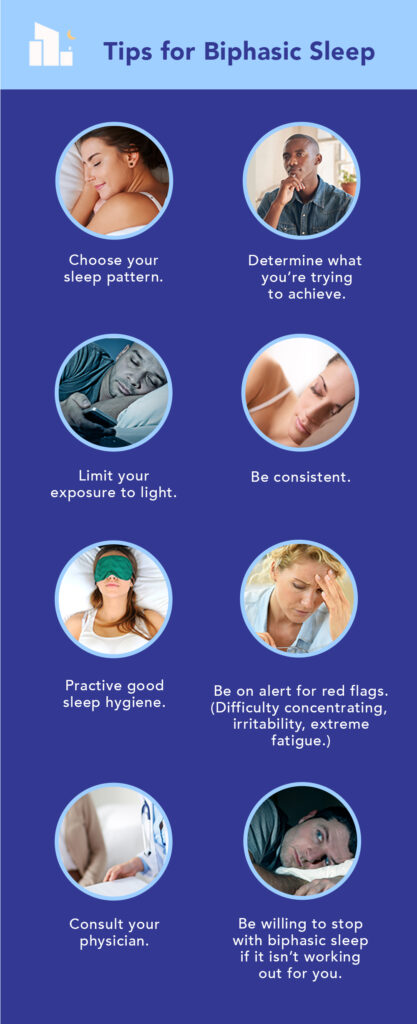Remember kindergarten? The days when afternoon naps were not only encouraged, they were a mandated part of every kid’s school schedule. We didn’t know it at the time, but those childhood naps represented a sleep pattern called biphasic sleep—and that pattern provided us with a lot of benefits.
Modern research suggests that sleeping twice in a 24-hour period (a sleep pattern that is alternately referred to as biphasic sleep, segmented sleep, or siesta sleep) may facilitate greater energy levels, alertness, cognitive function, and productivity.
Nevertheless, as we reach adulthood most of us are trained to compress all of our sleeptime into one overnight block. Most modern Americans are monophasic sleepers, which means we only sleep once—usually during the night—in a 24-hour period.
While monophasic sleep may be the norm among “grown ups”, more and more research suggests that we might be better off returning to the biphasic sleep patterns of our childhood. Here’s what biphasic sleep is all about, why there’s historical precedent for adopting this sleep pattern, the ways in which it might benefit you, and how to experiment with transforming your sleep style in favor of biphasic sleep.
Note: The content on Sleepopolis is meant to be informative in nature, but it shouldn’t be taken as medical advice, and it shouldn’t take the place of medical advice and supervision from a trained professional. If you feel you may be suffering from any sleep disorder or medical condition, please see your healthcare provider immediately.
What Is Biphasic Sleep?

You may not remember being an infant, but it’s still possible to say with certainty that you napped a lot as a baby. Instead of sleeping through the night, your sleep was divided up into multiple sessions throughout a 24-hour period. The same goes for every other human being who exists on this earth. This represents a sleep pattern called polyphasic sleep, which we’ll discuss below.
As you grew into toddlerhood and beyond, odds are good that you naturally cut back on the napping until you were sleeping for a longer chunk of time at night and then snoozing only once during the day. This represents one variation of biphasic sleep.
“Biphasic sleep” might sound like a sciencey term, but it actually defines a pretty simple concept. It’s just the name for a type of sleep pattern in which a person divides their sleeping time into two sessions. (For example, they might obtain part of their sleep during the night and then make up the rest of their sleeping time with a daytime nap.) Biphasic sleep is also sometimes referred to as bimodal, diphasic, divided, segmented, or siesta sleep.
All told, biphasic sleep is best defined by the following characteristics:
- It’s a sleep pattern that involves sleeping in two sessions during a 24-hour period.
- These two sessions might both take place at night, or they might consist of one longer session during the night and one shorter session during the day.
- Biphasic sleep is different from monophasic sleep, which involves sleeping for only one extended session (usually at night).
- Biphasic sleep also differs from polyphasic sleep, which involves sleeping for more than two sessions in a 24-hour period.
What Are the Different Types of Biphasic Sleep?
Biphasic sleep patterns can take a variety of forms. Here are perhaps the two most common approaches:
Two Sessions at Night
Some biphasic sleepers split their sleep into two sessions that both take place during the night. Here’s how it works:
- They might sleep for a few hours starting in the early evening/nighttime.
- Then they’ll wake up for a couple of hours during the night.
- Finally, they’ll sleep for several more hours until dawn (or maybe a bit later).
- All told, this sleep style yields approximately six to eight hours of sleep.
One Session at Night and One During the Day
The most common way to approach biphasic sleep is to split your sleep time between the nighttime and an afternoon nap. This biphasic sleep pattern is also referred to as “siesta sleep” and is common in many European cultures, such as in Spain and Greece. Here’s an overview:
- The length of time people sleep during the night and the length of their naps varies by personal preference.
- Some biphasic sleepers prefer to sleep for several hours during the night (usually in the neighborhood of six hours or so) and then nap for approximately 20 minutes or so in the afternoon.
- Others prefer to sleep for a shorter time period during the night (say, around five hours) and then take a longer nap of approximately 90 minutes in the afternoon.
As most biphasic sleepers will tell you that determining the right approach involves some trial and error. Everybody is different, so different people may find they’re best suited to one or the other biphasic pattern.
What’s the Difference Between Biphasic and Polyphasic Sleep?
If you’ve done research on biphasic sleep, odds are good that you’ve stumbled across the term “polyphasic sleep” as well. So what’s the difference?
The answer lies in the first syllable of each word. “Bi” is derived from Latin and means “two,” while “poly” means “many.” So while biphasic sleep involves sleeping for two different sessions in each 24-hour period, polyphasic sleep involves sleeping for many sessions (in other words, more than two) in that same time period.
Polyphasic sleepers may adopt a large variety of different sleep shift patterns. For example:
- They might sleep three times in a 24-hour period. This pattern is also referred to as triphasic sleep. It involves sleeping for approximately 90 minutes, waking up for six hours or so, sleeping for another 90 minutes, and so on, for a total of three cycles.
- They might prefer to sleep for a longer chunk of time at night (say, three to four hours) and then take several shorter naps during the day.
- They might choose to sleep for two shifts during the night and then take one nap during the day.
There are several more variations on the polyphasic sleep pattern, but these are some of the most common.
It should be noted that insomnia and other sleep disorders are not the same as intentionally adopting a polyphasic or biphasic sleep pattern. Some people may be “accidental” polyphasic sleepers—meaning they wake up several times during the night even if they don’t want to.
Bottom line? When distinguishing between biphasic and polyphasic sleep, the key takeaway is that polyphasic sleep involves three or more sleeping sessions, while biphasic sleep involves just two sessions. In both cases, people tend to notice the best results when they adopt one pattern and stick to it consistently.
The Side Effects and Risks of Polyphasic Sleep
Many people who attempt polyphasic sleep do so to sleep less than the 7-9 hours that are typically recommended for adults. It’s important to note that just like any other sleep routine that leads to getting less that the appropriate amount, polyphasic sleep can open you up to the side effects of sleep deprivation. Common short-term affects include:
- Lack of alertness
- Daytime sleepiness
- Fatigue
- Impaired memory
- Moodiness and irritability
Meanwhile, the long-term side effects include increased risk for heart attack, heart disease, diabetes, dementia, stroke, high blood pressure, and more. Additionally, studies show that the purported benefits of polyphasic sleep are not scientifically supported, and that the polyphasic schedules most commonly discussed have been associated with negative physical and mental outcomes, as well as adverse consequences for daytime performance.
What Is the History of Biphasic Sleep?
Biphasic sleep might sound like a newfangled idea to modern sleepers accustomed to a monophasic sleep pattern. But more and more research suggests that if you take the full spectrum of human history into account, biphasic sleep is actually more normal than sleeping soundly through the night.
In fact, biphasic sleep was the norm for most of human history. The majority of people enjoyed a biphasic sleeping pattern in which they would sleep for approximately four hours early in the night (a period dubbed “first sleep”), wake up for an hour or so (during which time they might reflect on their dreams, catch up on household chores, have sex, or simply relax), and then head back to sleep for another four-ish hours (dubbed “second sleep”).
References to this cultural sleeping pattern crop up throughout historical art, diaries, literature, and even medical texts. Historical figures including Plutarch, Virgil, Homer, and Chaucer all referred to the concept of first and second sleep. Well-known sleep researcher Roger Ekirch posits this habit wasn’t just common in European cultures; there’s also evidence it was par for the course in Australia, Latin America, and the Middle East.
The invention of the light bulb may be responsible for the western world’s shift away from a biphasic sleep pattern. The advent of electricity (and the concurrent Industrial Revolution) meant workdays could be extended instead of ending at the same time daylight did. This compressed the amount of time available for sleeping at night, which means most people didn’t have the luxury of enjoying two four-hour sleep sessions and an hour or so of wakefulness each night.
Meanwhile, streetlights facilitated nighttime socializing, which meant people were more likely to stay out late—further disrupting their ability to practice the old habit of biphasic sleep. By the 19th century, many western cultures had officially eschewed this sleeping pattern in favor of monophasic sleep habits—and the concept of middle-of-the-night insomnia became a diagnosis rather than a cultural ideal.
Even as most western cultures adopted a predominantly monophasic sleep pattern, our bodies haven’t necessarily been as quick to jump ship. (For the record, some cultures never abandoned biphasic sleep patterns. Spain, Greece, and many Latin American cultures continue to embrace mid-afternoon naps.) Biological and evolutionary influences are powerful, and research suggests they continue to assert themselves. Well-known research from the 1990s suggests people naturally shift toward biphasic sleep when they’re exposed to natural patterns of daylight and darkness. People whose bodies exhibit strong circadian rhythms are also likely to experience a natural wake-up during the night.
As more and more biphasic sleep research makes its way into the hands of sleep scientists and the general public, it’s possible those people living in cultures that don’t endorse siestas will gradually find themselves once again preferring humanity’s historical pattern of biphasic sleep.
Looking for the condensed version of biphasic sleep’s history? We’ve got you covered:
- For most of human history, people enjoyed biphasic sleep.
- Historical art, literature, and medical texts from the first days of recorded history are full of references to this sleep pattern.
- Historical research suggests biphasic sleep continued to be the norm throughout the Medieval and Renaissance time periods.
- The Industrial Revolution of the late 18th and early 19th centuries encouraged compressed sleep patterns so people could spend more time working. This began the rise of monophasic sleep.
- In the late 1800s, Thomas Edison invented the lightbulb. This further disrupted traditional biphasic sleep habits in several ways. People continued working later and started participating in nightlife, which left less time for sleeping. It became increasingly normal to compress sleep into one nighttime session.
- Today, our culture continues to favor monophasic sleep patterns over biphasic ones—even though research suggests that (when left to their own devices) human bodies tend to favor biphasic sleep.
What Are the Potential Benefits of Biphasic Sleep?
Why exactly do some cultures and modern-day trendsetters value biphasic sleep patterns? Turns out, this style of sleeping may offer a number of perks. Here are seven potential benefits of biphasic sleep.

- It may boost cognitive function. Sleeping for two sessions in a 24-hour period may improve cognitive function. That may be partly because it reduces feelings of tiredness and enhances the capacity for focus and concentration.
- It may improve productivity. Research suggests a biphasic sleep pattern may boost productivity. That’s largely because of the enhanced cognitive function described above, as well as an increase in alertness; together, these two factors make it possible to get more done. What’s more, this increase in productivity isn’t accompanied by a greater sense of tiredness or burnout.
- It may reduce stress. The nighttime wakefulness session practiced during the biphasic sleep patterns of yore was considered to be highly relaxing and an important way for people to manage their stress. It’s possible modern biphasic sleepers might enjoy the same benefits.
- For siesta sleepers, it yields all the benefits of power napping. Research suggests power naps can provide a wide range of benefits. These include boosting the capacity for learning, creative problem solving, logical reasoning, memory formation and recall, and greater cognitive performance overall. Power naps may also increase mental alertness, reduce fatigue, decrease the risk of making errors on the job, improve mood, and reduce stress.
- It enables flexible scheduling. Splitting your daily allotment of sleep into two sessions can create more flexibility for juggling work, family, and other responsibilities.
- It may improve dream recall. Research suggests biphasic sleeping may improve our ability to remember our dreams, which can give us greater access to our subconscious minds. This can yield personal insights into our feelings, thoughts, and so on.
- It may help people cope with insomnia. When people who are suffering from insomnia learn that humans long woke up in the middle of the night, it can help them feel less anxious about their own condition. And when their anxiety goes down, their sleep is more likely to improve.
Given these benefits, it’s no wonder biphasic sleep patterns are gradually starting to catch on among entrepreneurs and anyone else looking to hack their cognitive function and productivity.
What Are the Potential Downsides of Biphasic Sleep?
While biphasic sleep patterns pose a number of benefits, they may also come with some potential downsides.

For starters, transitioning to a new sleep schedule definitely involves an adjustment period. During this period, some people may experience feeling more tired, groggy, grumpy, and so on.
Additionally, shaking up your sleep schedule may disrupt the current dynamic within your social circle. For example, going to bed earlier might require spending fewer nights out with friends, while napping in the afternoon might cause conflicts in your office. These social ramifications often get in the way of people’s efforts to transition to a new sleep schedule.
Then there’s the dearth of research. There’s simply not that much research into the long-term effects of biphasic sleep patterns. This means sleep scientists aren’t yet sure if there are negative consequences to adopting a biphasic sleep pattern for an extended period of time.
What we do know is most experts advise healthy adults to get between 7-9 hours of sleep, so shifting to a biphasic sleep pattern and getting less than the recommended amount could lead to some undesirable short- and long-term side effects.
But for the most part, studies suggest biphasic sleep patterns are relatively harmless. So long as you’re still getting approximately seven to nine hours of sleep a night, most research suggests it’s fine if that sleep happens in two sessions.
Who Could Biphasic Sleep Be Good For?
Every person’s sleep needs and preferences are different, which means a biphasic sleep pattern is likely to be more suitable for some people than others.
Researchers aren’t yet sure what factors influence the way a body responds to biphasic sleep. What they know so far is that some people need eight consecutive hours of sleep in order to feel well-rested and capable of functioning at their best, while others thrive on shorter periods of extended sleep paired with daytime naps.
There may be a genetic component at play here. For example, research suggests only one to three percent of the population actually performs well on nothing but a few short hours of sleep a night—and that may be the result of a mutated gene. Unless you’re willing to shell out for genetic testing, there’s no way to know if you fall into this camp without experimentation. For the rest of us mortals, it’s essential to enjoy extended periods of quality sleep. Luckily, a biphasic sleep pattern doesn’t require sleeping for only a few short hours a night—which makes it much more accessible.
There’s also a lifestyle element. For example (as noted above), people who are juggling unusual work or family schedules may enjoy the flexibility afforded by a biphasic sleep schedule.
Finally, folks who are looking to get an edge up in their work life may benefit from biphasic sleeping thanks to the cognitive benefits described above.
Bottom line? Because sleep patterns aren’t one-size-fits-all, the only concrete way to determine what works best for you is to experiment with different sleep schedules until you find the one that feels best.
How to Try Biphasic Sleep

If you want to give biphasic sleep a try, keep in mind the following guidelines in order to set yourself up for the best chance of success.
Choose your sleep pattern.
Start by deciding which pattern of biphasic sleep you want to adopt. As a refresher, the two primary options are:
- Sleeping for approximately six hours at night (or longer) and then taking a 20-minute nap in the middle of the day.
- Sleeping for approximately five hours at night (or longer) and then taking a 60- to 90-minute nap in the afternoon.
When determining which style might work best for you, it can help to consider when you normally feel sleepy. For example, if you regularly experience an afternoon energy slump, this may be an ideal time to schedule a nap. If you normally wake up in the middle of the night, then maybe two nighttime sleep sessions would work best for you.
Determine what you’re trying to achieve.
Why do you want to experiment with a biphasic sleep schedule? Is it to improve your productivity at work, boost your cognitive functioning, reduce stress, cope with the sleep deprivation of having an infant at home, or something else entirely?
The answer may influence the way you approach your experiment. Identifying your goal will help you establish metrics to track whether a biphasic sleep pattern is making a positive difference in your life. Speaking of which: Once you’ve selected your goal, it’s a good idea to keep a sleep log so you can track your progress and adjust your sleep schedule as needed.
Limit your exposure to artificial light.
Artificial light can disrupt your circadian rhythms and make it difficult to fall and stay asleep during your sleep sessions. For this reason, it’s a good idea to limit your exposure to artificial lights by dimming the lights and turning off the TV in the hours leading up to bedtime, keeping electronics out of your sleep space, consider using blue light blockers, and so on. If you’ve chosen to adopt a wakefulness period in the middle of the night, try to minimize your exposure to artificial light during that time—otherwise, it might be difficult to fall back asleep for your second sleep session.
Be consistent.
Maintaining a fixed schedule is essential for training your body when it’s time for it to fall asleep. This helps ensure that you get restful sleep during each sleep session. What’s more, maintaining an irregular sleep schedule may backfire, as inconsistent schedules are associated with poor performance and disrupted sleep.
Practice good sleep hygiene.
Creating an environment that’s conducive to sleep will increase the likelihood that you’re able to fall and stay asleep during each of your sleep sessions. To that end, aim to sleep in a cool, dark, uncluttered, and quiet place. (As noted above, this space should be free from artificial light.) It’s also helpful to avoid drinking alcohol or exercising immediately before your sleep session.
Be on the alert for red flags.
As noted above, a non-monophasic sleep pattern works better for some people than others. Be on the lookout for signs that your body is not adjusting well, such as difficulty concentrating, irritability, extreme fatigue, unusual risk-taking, and/or falling asleep at inopportune times. If any of these issues crop up, it may be a sign that you should return to a monophasic sleep schedule.
On the other hand, if you’re feeling relatively well-rested, cheerful, and functional, that’s probably a good sign that your body is adjusting well to a biphasic sleep pattern.
Consult your physician.
It’s a good idea to get your doctor’s input before making any radical changes to your sleep cycle, since they’ll be able to tell you whether anything in your medical history might factor into your experience. This is especially important if you have a chronic health condition such as anxiety or depression, because messing with your sleep patterns may influence these conditions.
Be willing to drop the experiment if necessary.
If you’ve experimented with a biphasic sleep pattern for several weeks and you find it hasn’t really improved your energy levels or helped you achieve whatever goal you were aiming for, it may be time to ditch your experiment. This isn’t a sign of failure; it’s just a sign that biphasic sleeping may not be ideal for your particular body and/or lifestyle. There may also be factors at play that you aren’t even aware of; for instance, some people find that their sleep patterns need to change with the seasons in order to keep enjoying quality sleep.
The Last Word From Sleepopolis
Adopting a biphasic sleep pattern isn’t for everyone. But for some, making the switch from monophasic to biphasic sleep opens up a number of benefits ranging from increased alertness during the day to more flexible scheduling and greater productivity. If nothing else, the historical and scientific precedent for biphasic sleep patterns should make us all a little more open-minded when it comes to how different people sleep.


























